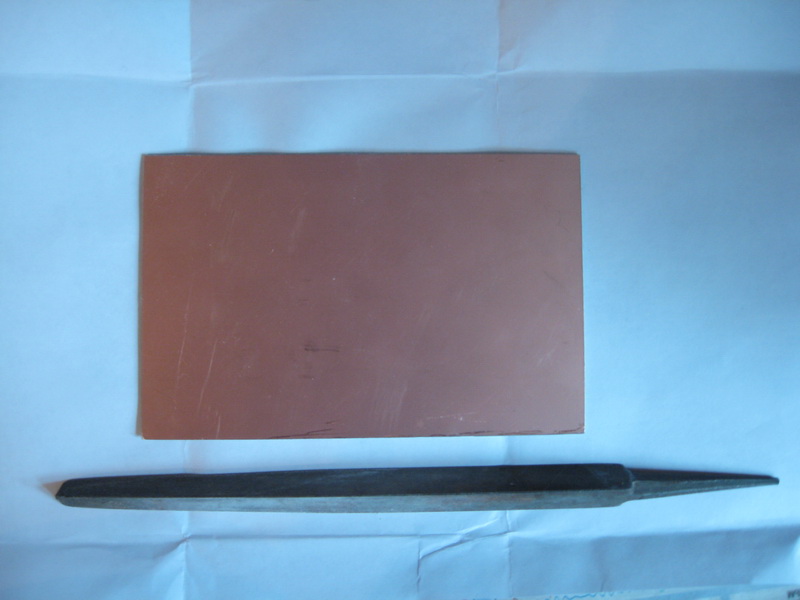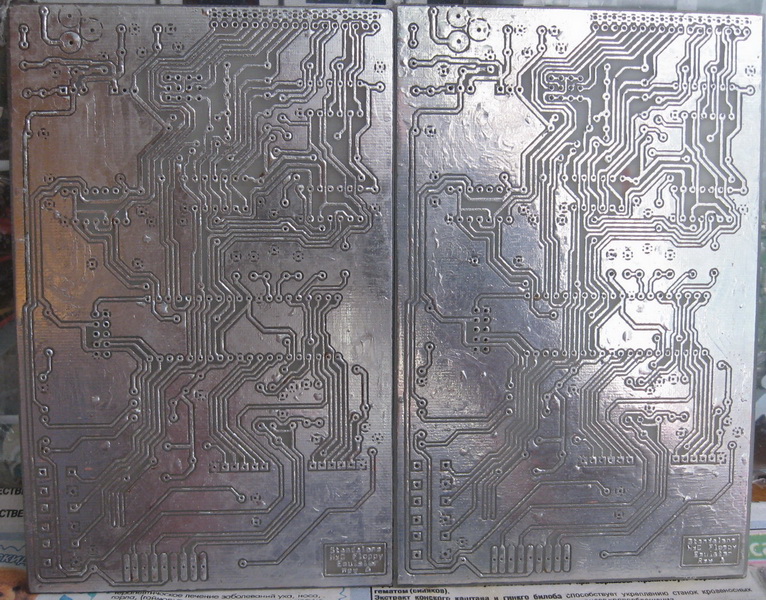PCB making at home |
RU |
№1 Old-School
Based on the geometric dimensions of the topology of the printed circuit board, we cut out a piece of fiberglass or getinax of the appropriate size. We process (grind) all the ends of the board with a large file, after that we process each face on both sides with a small file. We transfer our topology to a tracing paper of a slightly larger size, such that it is enough for us to wrap our piece of fiberglass. We take a core (I used a dowel) and core the holes. Next, remove the tracing paper, take a drill and a drill with a diameter of 0.8mm (for holes for conventional radio elements), 0.6mm (for holes for microcircuit pins) and drill. After that, we take a drill with a diameter of 2 ... 3 mm and countersink the holes from the opposite side (from the side of the installation of radio elements).
If our PCB is double-sided, then we countersink only unused holes. Having finished with countersinking, we grind our future printed circuit board with fine sandpaper on both sides. We press the sandpaper not much, because. applying great efforts, we reduce the thickness of the foil layer, and, as a result, the thickness of future conductors (tracks) on the board. Next, with a simple pencil, we combine the holes on both sides of the sides (if the board is double-sided) according to our developed topology. And now the most crucial moment - drawing a picture. This can be done in a variety of ways. Until recently, I did this with a glass drawing pen - this is a glass tube. They are sold in cardboard packaging in several pieces of different diameters. But, probably, they became in short supply and I never found them on sale. Therefore, I used a different method. The idea behind the method is this.
We take a needle from a medical syringe and bite off with wire cutters at a right angle so that about 25% of the entire length of the needle remains. We grind the end of the needle with sandpaper. Now we take nitro paint / quick-drying enamel / bitumen varnish (optional) and draw it in with a syringe through the needle. Try to draw an incomplete syringe, because. the paint, depending on the height of the column of paint in the syringe, will spread over the surface of the fiberglass. We tilt the syringe so that the inlet is at the top and remove the plunger. Now carefully apply the drawing and let it dry. After the paint has dried, we etch the board. I do this in a solution of ferric chloride FeCl3. The etching time depends on the area to be etched, the geometric dimensions of the printed circuit board, the concentration of the solution, and its temperature. If the solution is heated to 40-50 degrees Celsius, then the etching time is reduced by about 1.5-2 times. After the board is etched, we wash it under running water, wipe it dry and remove the paint from the conductors with the "P12" solvent. We cover the printed circuit board with a thin layer of flux (I use alcohol with rosin dissolved in it) and tin the printed conductors. After that, the flux residues from the surface of the printed circuit board are removed with alcohol. The printed circuit board is ready for mounting the radio elements.
№2 By iron
1. We make a drawing of the future printed circuit board on coated paper in a mirror;
2. We attach our drawing to the processed surface of the textolite;
3. We put the textolite with a pinned pattern in hot water;
4. Remove scraps of paper after soaking;
5. Next, we etch like a regular printed circuit board.
And now about this and other details...
1. Drawing: you can use special application programs to obtain the layout of the printed circuit board (for example, Eagle). I used CorelDraw (yes, I love to draw). We mirror the drawn topology of the printed circuit board and print it on coated paper. The chalk should be as thin as possible (nothing will work on a thick one - the toner will not stick properly). It is necessary to print on a HP4L / 5L / 6L printer. It is recommended to print on these printers because (as far as I know) HP printers after 6L do not give black, but give dark gray (HP after 6L are not suitable for tracing paper output in typography, since pure black is needed there, and not dark grey). In HP, they saw this and removed the ability to print in pure black, because. there was little demand for printers that are designed just for printing work). Today, when 2010 is coming to an end, printer lines are updated annually by manufacturers, such as HP. And, of course, we can already print on coated paper on newer printers. With the same success as HP5L, 6L, we can use HPLJ1018/1020/1022/2200/2300. It was on these printers that I carried out experimental printing on chalk - there are no problems, everything is OK. But the HP2420/3005 was a bit disappointing - the picture is smeared. This happens due to the fact that the speed of the HP2400 is not much, not a little - 28 pages per minute, the speed of the HP3005 is even higher. And if on ordinary paper with a density of 80 everything is printed without problems, then something is smeared on the chalk due to the high speed of the paper page.
It is necessary to print with the toner saving mode turned off and set the quality darker (maximum).
Do not touch the chalk sheet with your hands before and after printing. No fat allowed!
2. Sewing: cut out the textolite of the required size; with fine sandpaper we clean the surface of the textolite in various directions without pressing, the task is simply to make small scratches on the surface of the textolite so that the toner has something to catch on; degrease with a solvent, and preferably with alcohol - does not leave streaks on the surface; we put a chalk sheet with a printed pattern (topology) of our printed circuit board with the toner down and put the iron on top for 2-3 minutes. If the dimensions of the printed circuit board are large, then it is necessary to cut out the pattern of our future printed circuit board with a margin on all sides in order to tightly wrap the excess paper on the reverse side of the textolite in order to avoid shrinkage of the pattern with the printed pattern, and with an iron it is necessary to bake the chalk first over the entire surface area boards (chalk shrinks - it shrinks when heated and the conductor pattern may be distorted), and then warm up in sections for 30-40 seconds. If it is not possible to cut a template for baking larger than the printed circuit board, you can fix the edges of the template with adhesive tape or masking tape and stick them on the back of the future printed circuit board. Next, we take the iron and methodically, moderately pressing the iron, we grind each track. The main thing is not to overdo it, but also to underdo it, because. in the latter case, the tunnel layer will be etched and the current-carrying conductor (track) will break. If you overdo it - the toner will spread out on the sides and will be ugly (read - it will be necessary to redo it). The thinner the track, the better it will turn out. But the polygons are not very good, and I always cover them with nail polish, the cheapest and without sparkles.
A few photos to support the text
A piece of textolite is cut out. The sandpaper is not large, without pressing in a circular motion, we use sandpaper on the textolite, leaving behind small "scratches".
The glue left by the adhesive tape after the template is baked is easily removed with acetone, solvent, alcohol, and simply rolls off with the crumb of a finger with little effort. In the process of baking the areas on which the glued tape has fallen and which should be walked with an iron, cover with pieces of the same coated paper. It’s a little problematic, I agree, so it’s always advisable to print the template so that later you can cut it out with a margin around the perimeter and tightly wrap the excess paper on the back of the board for fixing (so as not to fool around with all sorts of adhesive tapes).
3. Soaking: place the textolite with a pinned chalk leaf in hot water and wait until it gets wet. Usually, in the descriptions of the laser-ironing technology, it is advised to let our future printed circuit board with a pinned pattern cool down in order to then place it in cold water for soaking. I have done this a couple of times - it makes no difference to the fact that I always put a hot scarf with a stitched pattern in hot water. In water, the chalk begins to delaminate (usually into three layers) and only the top layer with the pattern remains. When the paper is well soaked (20-35 minutes), we take out our textolite and roll up the rest of the tatters with a fingertip. On my printed circuit boards, I always make holes in the drawings for the radio parts and after soaking the chalk (if it needs to be soaked), sometimes (always, but not all) I scratch with a needle those holes that remained covered with a chalk layer. These holes are also etched, which eliminates the punching, and allows you to drill right away.
It is very difficult to tear off a well-moored toner with your finger, but accuracy will not hurt.
The photo clearly shows white fragments, which should be removed with a needle, as well as remove white patches from future holes. Checking the pattern on which - and our board is ready for etching.
4. Next, we etch it like a regular printed circuit board. I do this in a solution of ferric chloride FeCl3 + 6H2O (see method No. 1).
Tracks with a width of 0.8mm or more are obtained without problems. Tracks of smaller widths are even better if coated quality paper is available. On the mp3 player board under VS1001, the board drawing contains tracks 0.2mm wide with a gap between tracks of 0.35mm.
With proper care, you can also make a double-sided printed circuit board using the same method. How? Very simple. We do everything according to points 1 and 2. Next, from the side where the template with the pattern is already baked, we drill two holes diagonally on the board. In the template that will be placed on the second side, we simply pierce the same holes with a needle - the so-called. fiducial holes, they should be provided before printing templates. I use through holes in the board, through which signals flow according to the scheme, i.e. I don’t provide special reference holes, but I use those through ones that are on the board. We combine the template along the holes, fix it, fold the excess paper on the back of the board and make sure that our template has not shifted and bake our template. Next, follow steps 3 and 4. Example: the volume control board and Matyushkin's tone block on this page - these are not the most complex boards that I made double-sided. I made a couple of boards for a ROM-Disk for the ZXM-Phoenix computer, they are on the site - on the page about ZXM-Phoenix.

































